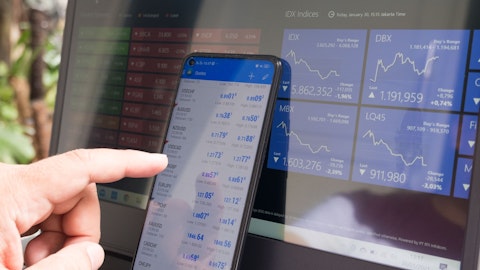Wayfair Inc. (NYSE:W) Q4 2023 Earnings Call Transcript February 22, 2024
Wayfair Inc. beats earnings expectations. Reported EPS is $-0.11, expectations were $-0.22. Wayfair Inc. isn’t one of the 30 most popular stocks among hedge funds at the end of the third quarter (see the details here).
Operator: Good morning. My name is Rob, and I will be your conference operator today. At this time, I would like to welcome everyone to the Wayfair Fourth Quarter 2023 Earnings Release and Conference Call. All lines have been placed on mute to prevent any background noise. After the speaker’s remarks, there will be a question-and-answer session. [Operator Instructions] Thank you. James Lamb, Head of Investor Relations and Treasury, you may begin your conference.
James Lamb: Good morning, and thank you for joining us. Today, we will review our fourth quarter 2023 results. With me are Niraj Shah, Co-Founder, Chief Executive Officer and Co-Chairman; Steve Conine, Co-Founder and Co-Chairman; and Kate Gulliver, Chief Financial Officer and Chief Administrative Officer. We will all be available for Q&A following today’s prepared remarks. I would like to remind you that our call today will consist of forward-looking statements, including, but not limited to, those regarding our future prospects, business strategies, industry trends and our financial performance, including guidance for the first quarter of 2024. All forward-looking statements made on today’s call are based on information available to us as of today’s date.
We cannot guarantee that any forward-looking statements will be accurate, although we believe that we have been reasonable in our expectations and assumptions. Our 10-K for 2023 and our subsequent SEC filings identify certain factors that could cause the company’s actual results to differ materially from those projected in any forward-looking statements made today. Except as required by law, we undertake no obligation to publicly update or revise any of these statements whether as a result of any new information, future events or otherwise. Also, please note that during this call, we will discuss certain non-GAAP financial measures, as we review the company’s performance, including adjusted EBITDA, adjusted EBITDA margin and free cash flow.
These non-GAAP financial measures should not be considered replacements for and should be read together with GAAP results. Please refer to the Investor Relations section of our website to obtain a copy of our earnings release and investor presentation, which contain descriptions of our non-GAAP financial measures and reconciliations of any non-GAAP measures to the nearest comparable GAAP measures. This call is being recorded and a webcast will be available for replay on our IR website. I would now like to turn the call over to Niraj.
Niraj Shah: Thanks, James, and good morning, everyone. We’re excited to be with you today to discuss our fourth quarter results and recap 2023. Q4 was one more definitive step on our profitability journey as we generated a 3% adjusted EBITDA margin, even in a difficult macro environment. This was our third consecutive quarter of positive adjusted EBITDA and free cash flow and a reflection of the immense progress we achieved across the entire year. In fact, on a revenue base that largely mirrored 2022, our free cash flow in 2023 improved by over $1 billion. As we exited 2022, we anchored ourselves around three core initiatives, nailing the basics, driving customer and supplier loyalty and cost efficiency. Over the course of 2023, we systematically executed on all three fronts.
Our efforts to nail the basics and drive customer and supplier loyalty led to a large improvement in our core recipe across availability, speed and price competitiveness. The improvements across our offering were directly responsible for the step-up we saw in loyalty, which manifested in our robust share expansion over the last year and by the fourth quarter, a return to year-over-year growth in our active customer count. That engagement was driven in part by our progress on the third initiative, a meaningful evolution in our cost structure with savings spanning labor, operations and every other line of our P&L, which allowed us to reinvest in our customer experience. We’ve consistently shared that those same core initiatives would carry forward into 2024, and you’ve already seen the results of that play out.
If you haven’t had the chance, I’d encourage you to take a look at our shareholder letter that was published alongside our earnings results earlier this morning. Last year, we saw our team unlock large productivity gains as focused execution against our top ideas, met reduced friction and less internal bureaucracy. As we look at the evolution and composition of our teams throughout 2023, it became increasingly clear to us that there was more that could be done to increase productivity. We realized that many of our teams were still over-indexed to middle and upper level managers in proportion to the more execution-focused team members that are the foundation of each group. Late last year, we started an exercise involving a number of our senior leaders to look at each team across the organization and answer some simple questions.
How would we maximize the efficiency of this team? How many people would be on it? What would the appropriate leveling look like? Would we actually prioritize all the activities the team does? And then we answered as if we were starting from a blank slate. We took this work and use it in conjunction with the effort we started in the summer of 2022 to return to our lean and fit self by reorganizing a rounded ideal structure. While this is not the work anyone enjoys being lean as a key part of our culture, and partly why we think we’ve out executed others over the last 20 years. The key here is that we are comfortable being frugal around headcount. We’re excited to welcome a group of new college graduates this summer, and we’ll allocate those hires to the key teams and efforts that will provide the biggest gains, all the while growing the foundational base of talent in the company who can rise through the ranks in the years to come.
This enables us to move forward against an ambitious set of growth initiatives, while at the same time, see our team thrive in a workplace where they have fewer obstacles, fewer meetings and fewer boxes to tick off to bring these initiatives to fruition. Many of you asked if the decision was made in reaction to what we’re seeing from the macro and the answer is no. Our intent was to address the structure of our award in a way that will unlock productivity gains, not just for one or two quarters, but for years to come. However, as we shared in our press release from last month, our category does remain challenged with softness persisting through the start of the year. I was recently at the furniture market in Las Vegas and had the opportunity to speak with many of our suppliers.
We heard that January was weak, though a short bout of extreme weather was clearly one factor. While uncertainty remains around the timing of a recovery, we are well positioned to see meaningful upside as suspending climate around the home and housing rebounds, and we continue to see our own growth well outpacing the category. It’s important to call out that our success is not exclusively against smaller home focused competitors. We’re also seeing share gains against some of the biggest retailers in the country. I mentioned earlier that we’ve been able to win through execution gains driven by a more nimble, focused team, and we’ve been encouraged to see that play out across the organization. One area that I’d like to highlight today is our UK business, where we’ve seen a noteworthy inflection in share over the past year.
The UK is a key market for us with an addressable market estimated to be in the $60 billion range. While the competitive ecosystem has strong similarity to the US with a mix of a few multinationals, a number of large multi-category retailers, several homeware specialists and a long tail of smaller competitors in various niches within the category. The actual list of names looks at almost entirely different. The market fragmentation works to our advantage, as we are one of the few scale players that focuses exclusively on the home. Over the past year, we’ve driven healthy market share growth on the back of considerable availability improvements, double-digit percentage growth in small parcel speed badging and meaningfully more competitive prices.
This was fueled by our operational efficiency initiatives that drove considerable savings dollars, some of which we were able to pass back to our customers. Our aided awareness in the UK is nearly as high as the US and we’ve seen an encouraging increase in customer satisfaction scores since the same time last year. Just as we do in Canada and Germany, we take a country-specific approach to servicing customers in the United Kingdom. Our creative is specifically built to emphasize UK tone of voice, along with using UK homes in our television ads, which you can view on our UK specific social channels. Leveraging our strength in logistics and our six UK Wayfair delivery terminals, we bring our UK customers a best-in-class fulfillment experience with services like scheduled delivery and white glove upgrades while also opening up a wider selection from suppliers based in Continental Europe.
We find that UK competitors frequently have much lower levels of selection, which makes our endless aisle even more compelling and positions Wayfair as an unparalleled option in the market. Now before I hand it over to Kate, I want to take a few minutes to address three of the topics around which we’ve heard the most interest. Let me start first with the Red Sea and Ocean Cargo situation, which we’ve gotten many questions about over the past couple of months. Like many others, we’ve seen some supply chain disruption, especially for our product being shipped to Europe through the Suez Canal. We’ve seen our carriers implement interim solutions, including routing shipments around the southern tip of Africa. It’s important to keep in mind the minor scope of supply chain disruption this poses in contrast to the type of disruption we faced back in 2021.
These new routes increased shipping time on a much more manageable basis than we faced in 2021, and availability across our catalog has seen no meaningful negative impact. Container prices have risen, but nowhere near the order of magnitude the industry faced a few years ago when rates reached $20,000 per container during the COVID crisis. So the net is that while rates have risen, it is something we’re very capable of managing without issue, and we’re already solving for that today. The second topic we’ve received questions on has been average order values. We know this has been tracked quite closely in recent quarters as the inflationary pressures for many of those same supply chain challenges have now finally worked their way out of the inventory picture.

Our AOV peaked in the second quarter of 2022 and by the end of that year, we began to see prices decline. We lapped those initial price drops this Q4 and saw that normalization process happening a bit more rapidly than we expected due in part to mix shift. We still anticipate seeing some modest negative year-over-year comparisons during the front half of this year as we approach a fully normalized pricing state midyear. The third topic we know investors are acutely focused on is a volatile macroeconomic backdrop as the category quickly approaches a new record for a peak to trough correction. As we said consistently, our focus is squarely on controlling the controllables. You’ve seen the enormous progress we’ve made on our cost structure in the last 18 months.
As part of our press release from January, we called out that we would expect to generate over $600 million of adjusted EBITDA this year on a hypothetical flat revenue scenario, which would translate to a margin north of 5%, putting us in a position to check the box on step two of our profitability ramp. And that only captures part of the substantial leverage, we’ve unlocked in our model with our true earnings profile, further augmented by the reductions we brought to bear on equity-based compensation and capital expenditures. With all the work we’ve done to optimize our fixed cost base, we’ll see even further benefits to the bottom-line, when the category recovers, as the high margin on flow-through of each incremental dollar of revenue will drive up the margin rate, quickly.
It’s important to reiterate that our work on cost savings hasn’t deterred our focus on delivering a best-in-class shopping experience. For example, we recently launched free white glove delivery on certain large parcel items, which we combine with Deluxe where our delivery agents on box an item, inspected for any flaws before the final delivery and greatly enhance the customer experience to seamlessly set the item up in the customer’s home and make sure it’s immediately ready for use. This is only possible to provide nationally with the scale and focus that Wayfair brings to the category. And it’s one of the many factors behind a return to positive active customer year-over-year growth this quarter. We’re eagerly looking forward to demonstrating the growth potential of our business, as the category recovers.
And I want to end by calling out some of the things I’m most excited for, in 2024. The first is the launch of our Wayfair branded store this May. We’re delighted to showcase the breadth and depth of our catalog in an entirely new way and can’t wait for you to see it. The second is the launch of our new brand campaign, which will roll out in mid-March. We’re bringing a vibrant refresh to the Wayfair brand with new merchandising, new marketing and new ways to connect with our shoppers. And the third is our plan to launch a tender-neutral loyalty program this fall, a new opportunity to create a differentiated shopping experience for our customers to keep them coming back time-and-time again. We have a lot of exciting things underway to help us keep driving, compounding gains.
With that, let me turn it over to Kate, to walk you through our financials.
Kate Gulliver: Thanks, Niraj, and good morning, everyone. Let’s dive into our fourth quarter results, beginning with revenue. Net revenue for the quarter came in at $3.1 billion, up 0.4% from the same period last year. Orders grew by 2.7% year-over-year, and we saw active customer growth return positive, up 1.4% year-over-year in the period. As Niraj discussed earlier, average order values came in higher than expected, down only 2.5% against the fourth quarter of last year as we saw boost from our performance in higher ticket classes during the holiday shopping season. I want to touch on the top line and macro context a bit before going further in the P&L. As Niraj shared in his remarks, our category broadly remains under pressure.
Within this context, we are very encouraged by our ongoing share gains and our continued ability to outpace the category. We’ve started this year with the best share figures we’ve seen across all the data we have in our credit card panel back to 2018. As we’ve shared previously, the share capture can be attributed to the return and strength of our core recipe in Q4 of 2022, as we improved availability, speed and price, driving a best-in-class customer experience. All of course, in the context of also aggressively managing our cost structure and driving profitability and free cash flow. I’ll now move further down the P&L. As I do, please note that the remaining financials include depreciation and amortization, but exclude equity-based compensation, related taxes and other adjustments.
I will use the same basis when discussing our outlook as well. Gross profit came in at 30.4% of net revenue as we saw the typical effects of holiday seasonality play out in tandem with our own proactive reinvestment of some operational savings that we had achieved earlier in the year. Customer service and merchant fees were 4.2% of net revenue and advertising was 12.2% of net revenue. Once again, there is a holiday effect here, which drove the sequential step-up in advertising dollars spent. Finally, selling, operations, technology, general and administrative costs or SOTG&A came in at $447 million for the fourth quarter. That was the impact of our work in 2022 and 2023 on driving fixed cost efficiency. We took SOTG&A down by over 13% in the full year 2023 versus 2022, and that doesn’t even capture the progress we made on reducing capital expenditures and incremental dilution from equity-based compensation.
Altogether, we had a third consecutive quarter of positive adjusted EBITDA and $92 million for the period or a 3% margin on net revenue. Our US segment drove $131 million of adjusted EBITDA at a 4.8% margin on net revenue, while our International segment adjusted EBITDA loss of $39 million with less than half the loss we had in the same quarter a year ago. We ended the year with $1.4 billion of cash and equivalents and $1.9 billion of total liquidity when adding the capacity from our undrawn revolving credit facility. Net cash from operations was $158 million, which was offset by $96 million of capital expenditures for free cash flow of $62 million for the fourth quarter and our third quarter in a row of positive free cash flow. Now let’s turn to guidance for the first quarter.
Beginning with the top line, quarter-to-date, we are trending down in the mid-single digits year-over-year and we would expect the full quarter to end in a similar place. We are continuing to win share among consumers but see the weight of a category correction now rivaling the great financial crisis dragging on top line growth. To put this in perspective, our read of various data sources shows the category declining year-over-year now for nine consecutive quarters, with the last six quarters exhibiting double-digit contraction. Although the timing is inherently uncertain, when macro pressures on our categories and interest rates eventually ease, we are set up to benefit meaningfully on revenue growth and profitability flow through. Moving on to gross margins.
We would continue to guide you to the 30% to 31% range as the appropriate place to model. As we’ve said for over a year now, we intend to be very tactical in our decisions around investing some of our gross margin back into the customer experience. In light of the volatile start to the year for the category, we anticipate that we will continue to prioritize those investments. Customer service and merchant fees should be between 4% and 4.5% of net revenue, reflecting some of the cost takeout from the workforce realignment plan we enacted last month. We expect this to trend closer to the 4% mark as we run rate the full savings by Q2. Advertising should stay in an 11.5% to 12.5% range, and SOTG&A should be in a range of $410 million to $420 million.
Following this guidance through, we would expect adjusted EBITDA margins in the positive low single-digit range for Q1, which we would expect to be a low point, both on a dollar and margin basis for the full year. While we don’t offer full year guidance, I want to refer back to remarks we made on our third quarter call. It is critically important for us to deliver on our commitment of substantial adjusted EBITDA growth in 2024. We have multiple levers at our disposal to drive adjusted EBITDA independent of the top-line. Even if the macro environment remains challenged across 2024, we have line of sight to full year 2024 adjusted EBITDA growth north of 50% year-over-year. As you’re modeling, it’s worth bearing in mind that the first quarter is typically the period where we see an initial outflow of cash during the year given our negative cash conversion cycle, which reverses as revenue build in the spring.
Now let me touch on a few housekeeping items. You should expect equity-based compensation and related taxes of roughly $110 million to $130 million, reflecting the healthy progress we made on cost takeouts. Depreciation and amortization of approximately $103 million to $108 million, net interest expense of approximately $5 million, weighted average shares outstanding of approximately $120 million and CapEx in an $80 million to $90 million range. As I wrap up, I want to spend a moment addressing the topic of capital structure planning as we look at the maturities coming due over the next couple of years. The meaningful improvement in our financial profile over 2023 in combination with the cost action we took last month, has given us broad optionality in managing the convertible notes that come due in the fall of this year and 2025.
Looking out at the macro and our own cash flow profile, we are prioritizing prudency. Our goal, as always, is to maximize value to Wayfair’s shareholders, and we are extensively evaluating the best timing and options to achieve this. Due to the hard work of the last year, we believe we’ve expanded our option set. For example, the improvements in our pro forma financial profile enable us to pay down the notes in cash and remain opportunistic around any potential refinancing activity. Before moving into Q&A, I would like to return to what Niraj touched on earlier. 2023 truly was a year of meaningful progress for Wayfair. Our market share gains and a return to active customer growth clearly show that we are the premier shopping destination for the home.
This foundation positions us incredibly well to reaccelerate towards the growth algorithm we laid out at Investor Day once the category stabilizes. As importantly, we have made considerable improvements up and down the cost structure with a clearly demonstrated discipline that carries forward to 2024 and beyond. The combination of these elements, along with all of the exciting innovation we have in store, makes me more confident than ever about the bright future ahead for Wayfair. Thank you. And now Niraj, Steve and I will be happy to take your questions.
See also Top 20 Fastest Growing Industries in the Next 5 Years: Predictions and 30 Safest Countries In the World in 2024.
Q&A Session
Follow Wayfair Inc. (NYSE:W)
Follow Wayfair Inc. (NYSE:W)
Operator: [Operator Instructions] Your first question comes from the Simeon Gutman from Morgan Stanley. Your line is open.
Simeon Gutman: Hey. Good morning, everyone. I wanted to ask first about the spread of your share gains vis-à-vis the industry, if you can contextualize it all where, I don’t know, e-com or total industry is trending? And then what gives you confidence that spread holds throughout the year or could even expand?
Niraj Shah: Thanks, Simeon. This is Niraj. Sure. Let me answer that. So first on market share, obviously, there’s a lot of ways to calculate market share. I’d say our main two ways we do that or we have a credit card data set we get, which has close to 100 competitors on it, and that gives us really good granular data at the competitor level and in total. The second is we talk to our suppliers lately, and they share how we’re doing, and they’ll share details relative to specific competitors. And while that’s less of a quantitative read, that’s a pretty dense detailed read. And so we use those two. But if you zoom out, the easiest one is just to look at our revenue, right? And if you zoom way out, you see our revenue was up just under 0.5% in the quarter year-over-year.
I think if you look at competitors, depending on the category you pick, you’re going to see numbers negative 10, negative 15. You’re going to basically see numbers even maybe higher than that some are going to negative 20, that’s where the category was year-over-year. So obviously, that delta is the share that we took because obviously, the revenue is customers voting with their dollars, that’s the market share. So we are – the way to think about it for five quarters now since the fourth quarter of 2022, we’ve been taking away taking share, and that was basically on the back of availability and price starting to recover post COVID in the December 2022. By the fourth quarter of 2022, we had that recipe back in tax. So we very quickly started picking up the share, the low-hanging fruit of the share.
But then even though that got hard after that as we hit all-time highs, we’ve continued to take share. And so our all-time high — we keep hitting all-time highs in market share as the quarters go by. And so what we would expect to happen is that you’re going to see the category for a period of time in the near term, be challenged. So the year-over-year numbers for the total category will be not great. And you’re going to see us outpacing them significantly, thereby picking up incremental share continuing to hit all-time highs. So I don’t know if that helps with the context of what we expect. But that’s sort of the way we see it. And then the only other comment I would make is, obviously, we would expect the category to subsequently recover.
It’s a cyclical category. And it was interesting, I was reading a note someone put out about the Home Depot called the other day. I hope people do say a well-run company, but obviously, is in the home category as well, and they’re talking about how certain segments are challenged right now, what have you. But not talk about how from a cost and a revenue potential standpoint, they’re really poised for huge gains once the category recovers. And what I would point out is like that’s also how we feel we are. So in other words, we’re taking share while it’s really hard to take share as the market is shrinking. It’s a challenging time to make sure as competitors don’t want to give up share. But we’ve taken up $2 billion in cost, close to it. We’ve gotten ourselves where the unit economics are very strong.
We’ve got customers really responding to what we’re doing. You see that in the market share you see in the active customer count, which has picked up and so as the market turns and demand comes back, I think you’re going to see quite a nice acceleration in revenue and profits as well. So while the market is tough, you’re going to see us continue to tick away just with the execution we’re doing. And then you’re only going to see that get a lot better as the market recovers.
Simeon Gutman: And to that point, and this will be the follow-up. As sales recover, what is the right way to think about incrementals for every point above zero? And then alternatively, if it stays negative for the medium term, is there a way to think about decrementals?
Niraj Shah: Yeah, sure. So I think the way to think about – so actually, one thing I’ll just put a plug in for is that we, today, along with obviously the earnings call materials, one of the things we released on the investor website is our annual shareholder letter and as title say, we only do that, obviously, once a year. So it’s an opportunity to look out to the future and for us to share our thinking on a bunch of topics. And I really encourage everyone on the call to just take a few minutes to download that and read it. It’s right on the IR website. Because there, we can really share some detailed thinking about what we’re focused on, which is not so much the near term focus as the call tends to be. But one of the things I do mention is how we think about how we’re poised for future earnings.
And I talk about how the next $1 billion of revenue would flow through in the mid to high teens on EBITDA. And that’s basically the concept. We have fixed costs in the business, and we get to leverage those as we grow. So there’s – that’s hopefully your point on kind of how – what’s the incremental potential look like?
Kate Gulliver: Yes. Simeon, it’s Kate. Good morning. I guess what I would add to that, too, you asked sort of going the other way. And in the prepared remarks, I referenced the comment that we made on the third quarter call around substantial EBITDA growth. And I said, somewhat irrespective of the top line, we expect to see 15% EBITDA growth is really up floor. So even with ongoing challenging macro or in your scenario, a potential contraction ongoing, we would still expect pretty significant EBITDA growth in 2024 due to the cost actions that we’ve already taken.
Simeon Gutman: Thank you, both.
Operator: Your next question comes from the line of Alexandra Steiger from Goldman Sachs. Your line is open.
Alexandra Steiger: Great. Thank you so much. So you’ve been very clear that reducing headcounts over the past few months have been a driver of efficiency and productivity within the organization. Where are we in that journey? Do you think there is more room for efficiencies? And when do you think it’s actually the right time to start rehiring grow head count again? And then my second question for Kate. Could you just elaborate a little bit more on your Q1 revenue guide in terms of drivers behind the outlook and the factors that are inside versus outside your control? Thank you.
Niraj Shah: Why don’t I answer the first part and then I then turn it over to Kate for your second part there. On the productivity, efficiency gains, head count side, I think the way to think about it is, we obviously did reduce head count over the last 18 months. But this last time, what we did is we did it with first and foremost in eye to what we thought a very efficient organizational model would be versus a cost savings target or something like that is the initial going-in goal. And so we think we’ve set up what will be a very efficient organization. There is some head count we will add to that, but it’s modest in the scheme of the head count we have and what it really does, it lets us really reformulate teams including a lot of the more junior members of those teams, which during the COVID period, we hadn’t hired.
And so we didn’t have as many of those folks on the team as would make sense from a ratio standpoint. And so with the college hires will join, we’ll have them there. But that’s from like an incremental head count cost standpoint, that’s not a big number. And what we think is that there’s a lot of productivity gains to come and that comes from a few different things. One, it comes from with the organizational model we set up, we think it enables folks to move faster and get more done. We’re already seeing early signs of that. Second, we think then a lot of people are in new roles. So then as they get settled in as they’re executing, we think there’s compounding gains there. And then the last piece is we’ve spent a lot of the last couple of years on a technology transformation and re-platforming our core technology stack.
And as we’re nearing the later stages of that, we get a lot of gains from when we build feature function on the new technology. It’s much faster to build and much flexible. And those games will come in the future, but we’re nearing that point. So we’re quite — we feel quite good about how productivity will continue to compound as we go forward.
Kate Gulliver: Yes. So as you know, on your revenue question, a few thoughts there. Obviously, the macro context is the macro context. We don’t drive that. But we have been focused for the past fixed quarters on controlling what we can control. And as it pertains to revenue, a key piece of that is the recipe. So price, availability and speed. You heard your speak to that. That’s been driving our share gains and we think we’ve done a really great job driving gains in what has been a challenging market. As it particularly pertains to this quarter, we’re obviously, sitting on this call deep into the quarter at this point. And so I just point you to that as you think about our quarter-to-date number and referencing that is generally what you expect for the quarter.
Alexandra Steiger: Great. Thank you.
Operator: Your next question comes from the line of Brian Nagel from Oppenheimer. Your line is open.
Brian Nagel: Hi, good morning. Thanks as always for the details. So I have a couple of questions here. I know the first one is going to be a follow-up. Just with regard to that, the guidance — the top line guidance you’ve given here for Q1, should we interpret that to mean that if you’re down mid-single digits, the backdrop of Wayfair has actually gotten more difficult here. And I recognize there’s a lot of seasonality and such. But as we’ve gone from Q3, Q4 and then into Q1, as the backdrop actually gotten more difficult. And then my follow-up question, unrelated, Kate, thanks for all the details there with respect to the balance sheet. I guess maybe if you could help us understand better. You’ve obviously repositioned the business extraordinarily well. You have a better year and a better cash position, cash flow position, but how should we think about the timing of some of these actions on the balance sheet?
Niraj Shah: Okay. Great. Brian, why don’t I – On your first part of your question, where you talk about is the backdrop getting more difficult. I think what you’re referring to there is, has the macroeconomic climate gotten tougher. I think that’s kind of where you’re going with that. And we would say, yes, we would say that the macroeconomic climate has gotten tougher. I think that is what — we just read comments from a lot of other retailers that have made public comments. That’s what I think you’re hearing broadly we’ve seen that in the credit card data. And I was at the Vegas furniture market, which I referenced earlier in January was particularly tough. Now, there was some bad weather in there that was temporal. So things have gotten a little better since.
But the market is softer than you would have thought it would be if it was kind of like sequentially just kind of modestly seasonality adjusted flat. So I’d say the macro has gotten tougher, but I will also point out the macro, the depth of the macro drawdown now is quite significant. So it’s kind of like, again, someone — I forget who know it was, they referred to like demand bouncing along the bottom. And I’d say that’s kind of like generally what we would think it roughly is, but you can’t predict the macro. So that’s why we focus more on the internal execution on the recipe. We focus on the internal drivers that we know will let us take share, that will let us outcompete others and do well regardless of what the market size is. And we — just in this quarter, to date, so not the fourth quarter, but the first quarter our market share has continued to climb.
So we’re still hitting all-time highs. We’re continuing meaning, we’re climbing — we’re hitting new all-time highs.
Kate Gulliver: Thank you for the question on capital structure. As you pointed out, we’ve seen significant changes in the profitablity and free cash flow nature of the business. And that broadly gives us optionality on capital structure. So as I said in the prepared remarks, one of notions [ph] actually is to pay the 2025s op in cash and we think that is a good and viable option. That said, we’re very focused on what is most economically efficient for our shareholders and best for the business. And we intend to be prudent and thoughtful. And so we continue to be a wide range of options from cash payments or refinancing to a combination. With regards to your question on timing, it’s worth noting that each quarter that our financial profile continues to improve and our free cash flow generation improves, obviously, the cost of capital for us continues to come down, and so there is some benefit there to the timing as well.
Brian Nagel: Very helpful. I appreciate. Thank you.
Operator: Your next question comes from the line of Anna Andreeva from Needham. Your line is open. Anna Andreeva, your line is open.
Anna Andreeva: Apologies. Good morning, guys. Thanks so much. Can you talk about if you’re seeing anything different with demand across various household incomes, is it the lower-income consumer that’s more pressure so far in 1Q? And also curious on performance of other high-margin brands in a portfolio outside of core Wayfair banner, headed to specialty retail and the Wayfair professional perform that’s either in the fourth quarter or so far quarter-to-date? Thank you so much.
Niraj Shah: Thanks, Ann. So a few thoughts on that. So first, you do see demand get increasingly pressured as you move down the income levels. So, obviously, you would expect that, but we see that in our data, and we also see that in the macro data we get from – particularly some of the banks and credit card companies. So I’d say that trend is pretty clean and pretty obvious. And so I think there’s nothing surprising to that. And then in terms of our brands, when you talk about our brand and specialty brands, which play above mass and then the luxury platform Perigold, which plays above that, you’re seeing that those hiring ones are doing quite well. And Perigold, I mean the luxury market is much less competitive, but it’s growing at very significant rates.
And part of that is, it’s smaller than Wayfair, but we have small market share everywhere. It’s just — that’s a relatively young brand for us. It’s executing very well. And as we mentioned a minute ago, that higher end market is less pressure. So it’s a much better plus, but it’s growing significant growth rates.
Operator: Your next question comes from the line of Colin Sebastian from Baird. Your line is open.





